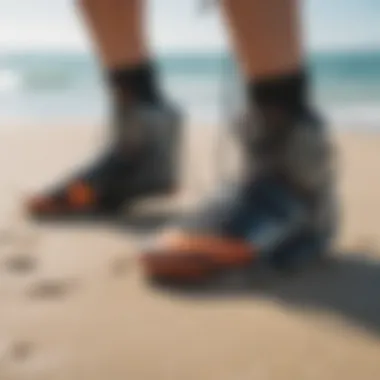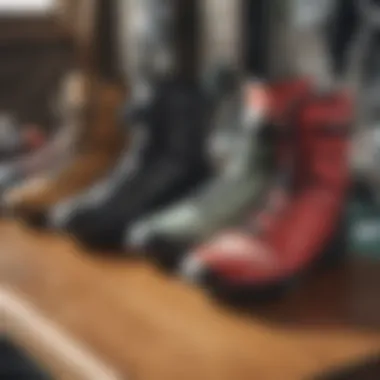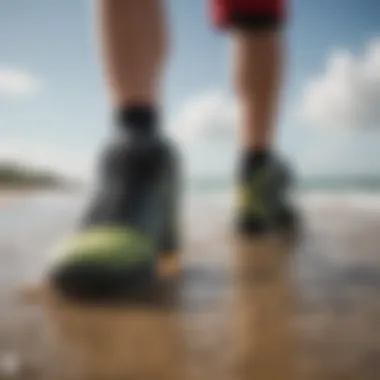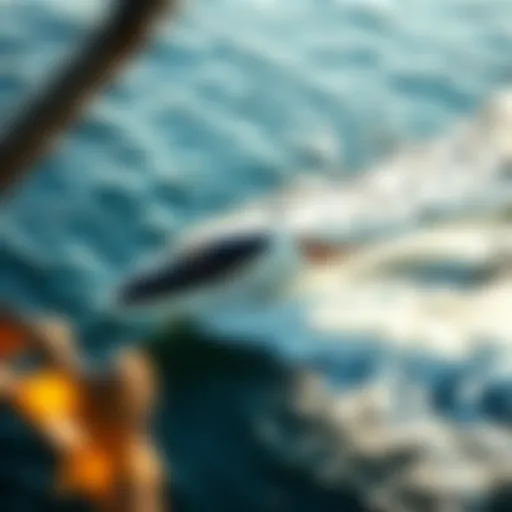Kitesurf Booties: Essential Gear for Every Rider


Intro
When it comes to kitesurfing, the right gear can be the difference between a thrilling ride and a downright painful experience. Among the essential equipment that often gets overlooked are kitesurf booties. These specialized footwear pieces serve not only as a protective layer but also as a vital contributor to your overall performance on the water. Understanding their significance can enhance your enjoyment of the sport and keep your feet safe from the often harsh conditions of the ocean.
Kitesurf booties come in a variety of materials and designs, each serving distinct purposes and needs. As we plunge into this guide, we’ll tackle the basic aspects of kitesurf booties, from types and benefits to practical tips on selection and maintenance. This is essential knowledge for kiteboarders looking to fine-tune their rides and make informed choices.
The world of kitesurfing is vast and textured, weaving together safety, comfort, and performance. Whether you're a rookie feeling the wind for the first time or a seasoned rider aiming to elevate your skills, understanding the role of booties can be the key that unlocks a new level of proficiency and confidence.
Let’s get right into it.
Understanding Kitesurf Booties
In the realm of kitesurfing, enthusiasts often emphasize the significance of gear. Among these, kitesurf booties stand out, not just as a fashion statement on the water, but as essential tools that enhance performance. Understanding kitesurf booties is more than just knowing their purpose; it’s about recognizing how they contribute to a rider's overall experience on the waves.
Defining Kitesurf Booties
Kitesurf booties are specialized footwear designed for riders to wear while kitesurfing. They are typically made from materials such as neoprene, which provides insulation and flexibility. Having the proper booties ensures that your feet stay warm and protected from the harsh conditions of the ocean floor, including sharp rocks, jellyfish, and other hazards.
But it’s not just about protection. The design of these booties also plays a crucial role in how well a rider can maneuver their board. A well-constructed pair of booties allows for a natural feel while steering the board, ensuring that the rider maintains optimal control. This balance between comfort and functionality is what makes kitesurf booties indispensable.
Historical Perspective
Kitesurfing has evolved significantly since its inception in the late 20th century. Early riders often used regular water shoes or even went barefoot, but they quickly discovered the drawbacks of such choices. As the sport gained momentum, so did the need for specialized gear. The first kitesurf booties were rudimentary compared to what’s available today; they were simply glorified socks.
Over time, manufacturers sought ways to enhance the functionality of these booties. New materials were developed to improve durability and comfort, and designs became more sophisticated.
Kitesurf booties have now segmented into various styles, tailored for specific conditions—warm water versus cold, flat water versus choppy conditions. This evolution mirrors the growth of the sport itself, as kitesurfers continue to demand gear that not only meets safety standards but also enhances their performance on the water.
"The right gear can make all the difference—it's not just about riding, it's about thriving in every condition."
Kitesurf booties now serve as a testament to the dedication of designers and kiteboarders alike, demonstrating how equipment can evolve alongside the sport. Understanding these booties in their historical context helps enthusiasts appreciate the technology and thought that go into modern designs.
Material Composition
Understanding the materials that go into kitesurf booties is essential for any kiteboarding enthusiast. The type of material can dramatically affect your performance on the water, your comfort level, and even the longevity of your gear. Different materials offer distinct advantages and drawbacks, influencing the booties' functionality in diverse weather conditions and water environments. A keen grasp of these components will help you make an informed decision when selecting the perfect pair for your needs.
Neoprene vs. Other Materials
Neoprene has long been the go-to material for kitesurf booties, and for good reason. It's not just a popular choice; it's a material that embodies the perfect balance between flexibility and insulation. Neoprene's ability to stretch allows for an excellent fit around the foot and ankle, ensuring a snug feel during crucial maneuvers on the water. The thickness of neoprene can vary, offering varying levels of warmth and protection depending on the conditions, which is something all kitesurfers should consider.
However, other materials, such as rubber or synthetic blends, have their own merits. Rubber, for instance, provides exceptional grip and durability. It can stand up to sharp objects like barnacles or rocks, reducing the wear and tear often seen with more flexible materials. Synthetic blends can also offer unique features, like increased water drainage and lightweight property.
In the end, the choice between neoprene and other materials boils down to personal preference as each material serves its purpose effectively.
Insulation and Breathability
Insulation is not just a luxury but a necessity when it comes to kitesurf boots. Depending on the climate of your favorite kitesurfing spots, the right insulation can mean the difference between an enjoyable session and a chilly outing that cuts your fun short. Neoprene booties with appropriate thickness offer warmth while still allowing for some degree of flexibility. There’s a sweet spot in thickness; too thick, and you lose the dexterity needed for precise control, too thin, and you might as well have been barefoot.
On the flip side, breathability should not be overlooked. While insulation keeps you warm, breathability ensures that your feet don’t turn into a sauna during your ride. Look for booties that incorporate perforated designs or specialized linings that allow moisture and sweat to escape. This can make a world of difference on those hot summer days when you’re pushing through lengthy sessions.
In short, a balance between insulation and breathability is essential to maintain comfort and performance on the water, especially when tackling various weather conditions.
Choosing kitesurf booties based on material composition not only impacts your enjoyment and safety but can also influence your overall experience during the sport. The marriage of flexibility, insulation, and breathability leads to optimum performance on the waves.
Design and Construction
When it comes to kitesurf booties, design and construction play a key role in how booties perform on the water and how well they protect your feet. The right design can enhance your performance, while smart construction ensures durability and comfort. An attentive approach to these aspects leads to better traction, support, and adaptability to varying weather conditions.
Variety of Designs
Kitesurf booties come in an assortment of designs tailored for different preferences and conditions. Whether you're a beginner navigating gentle waves or an expert tackling high winds, a design to fit your needs undoubtedly exists.
Several popular styles include:


- High-tops: These booties provide added ankle support and are beneficial in colder waters.
- Low-cut: Easier to slip on and off, these allow for greater freedom of movement, perfect for warmer climates.
- Split-toe designs: Often preferred for better board feel, they help riders maintain connection with the board as they maneuver.
Choosing the right design should vary based on the environment where one plans to kitesurf. Booties designed for rocky beaches may include reinforced soles for protection, while those intended for lagoons might focus on flexibility and lightness.
Key Features to Consider
Understanding the construction features of kitesurf booties is essential for anyone looking to optimize their kitesurfing experience. Three primary factors come to mind when assessing booties:
Thickness
The thickness of kitesurf booties is crucial for temperature regulation and comfort. Generally, thicker booties provide better insulation against cold water, which can be a big plus during early morning sessions or in cooler climates. Typically, you will find thicknesses ranging from 2mm to 7mm, depending on the desired level of warmth.
While thicker materials can keep your feet warm, they can also compromise flexibility. A thick boot may not flex as well when riding, potentially interfering with performance. Pros often prefer thinner booties for a feeling of connection with the board, believing it enhances precision during tricky maneuvers.
Sole Type
The sole type of kitesurf booties greatly influences traction and control on the board. Most booties feature rubber soles, but the level of grip can vary significantly.
- Flat soles: These provide stability and are often favored by those who ride in flat water.
- Textured/grippy soles: More adept at managing varied terrain, they offer superior grip on the board, particularly in choppy waters or during tricks.
Choosing the right sole can be a game-changer, as it affects how well you connect with your board and your ability to perform intricate maneuvers. A sole that provides too much grip can hinder quick foot adjustments, while too little may result in slips when you need to maintain control.
Seam Construction
Seam construction is another pivotal aspect of bootie performance, affecting both durability and waterproofing. A bootie with blind-stitched seams is known for being particularly waterproof, as the stitching technique limits water entry.
In contrast, flat-lock seams often provide comfort, but they may not be the best choice if you're venturing into chilly waters.
Ultimately, the durability of seams can determine how well a bootie holds up to wear and tear. A well-constructed pair will withstand the rigors of kitesurfing, ensuring that you won’t find yourself with a leaky or torn bootie in the middle of an exhilarating session.
"The right design and construction of kitesurf booties can make or break your experience on the water."
In short, understanding the variety of designs along with thickness, sole type, and seam construction will undoubtedly help you find the most suitable booties for your next kitesurfing adventure.
Importance of Fit
Getting the fit of your kitesurf booties right is not just a matter of comfort, but it is vital for achieving optimal performance on the water. A snug fit allows for better control during rides. If the booties are too loose, you’ll feel every wave and gust, and that can be both jarring and unsafe. If they’re too tight, well, that can lead to discomfort and, ultimately, impaired mobility. In essence, the right fit becomes your partner in performance, enabling you to focus on the thrill of kitesurfing instead of distracting aches or the risk of losing your footwear during a trick.
Sizing Guide
Understanding how to size kitesurf booties can feel like navigating a maze sometimes. Each brand might have slightly different sizing charts, and local stores often carry their own variations. Here are some valuable tips:
- Measuring Your Feet: Before you even grab a pair, take a moment to measure your feet. Use a tape measure or ruler to get both the length and width of your feet for an accurate fit.
- Check Sizes Against Brand Guides: Always consult the size chart of each brand you consider. Brands like O'Neill or Rip Curl are known for providing specific fitting guides that cater to their designs.
- Consider Foot Shape: Everyone's feet are unique. A "D" width might be perfect for some, while others might need a wide fit. If you have flat feet or high arches, think about features like additional padding or support.
When choosing size, remember that foot movement is crucial for kitesurfing. It’s better to err slightly on the side of snug than loose.
Testing for Comfort
Before splashing down into the water, perform some simple tests to ascertain if your kitesurf booties will indeed provide the comfort they promise.
- Walk Around: Put on the booties and walk around your house or the shop. There shouldn't be any pinching or uncomfortable spots. The more up-and-down movement your foot can do comfortably, the better.
- Flex and Bend: You want to check how easily you can flex your foot while wearing the booties. Bend down to tie your laces or check if you're still able to get your feet onto the board effectively.
- Staying Power: When you dip your feet into water, don't forget to feel if the booties maintain their grip. This matters especially when you're in the middle of a wave.
"The right fit today means a better session tomorrow. Don't rush, take the time to find the bootie that feels like a second skin."
In sum, finding the right fit in kitesurf booties is about balancing comfort, performance, and function. When you choose wisely, you not only elevate your adventures but also safeguard your feet as you ride the winds.
Advantages of Kitesurf Booties
When it comes to kitesurfing, every detail counts, especially when it comes to footgear. The windy waves tested by enthusiasts underscore the vital role that kitesurf booties can play. These specialized footwear items are not just a fashion statement; they are integral to enhancing performance, ensuring safety, and providing comfort in various conditions. Below, we delve into the specific advantages that kitesurf booties offer, making them a staple in any kiteboarder's kit.
Performance Enhancement
Selecting the right booties can drastically improve a rider's performance on the water. These booties are designed particularly for the dynamic movements associated with kitesurfing. With a good grip on the board, you can steer with confidence and precision. The soles on kitesurf booties are often made from materials engineered for traction; this can help prevent slipping, especially on wet surfaces. When your feet are secure, you feel more empowered to experiment with new tricks, enhancing your overall skill set.


Moreover, there’s a noticeable performance improvement when booties provide supportive fit. Your feet and ankles are better stabilized, reducing the likelihood of fatigue over long sessions. This means you can stay out longer and enjoy the ride instead of feeling worn out sooner than you’d like.
Injury Prevention
One cannot overlook the potential hazards of kitesurfing—whether it’s sharp shells hidden beneath the waves or the risk of ankle sprains from sudden movements. Kitesurf booties guard against these dangers effectively. They offer a protective barrier against cuts and scrapes that can easily occur when riding over variable terrain.
Additionally, the right pair can also act as a shock absorber. The cushioning in quality booties reduces the impact felt during landings, which is a major boon for those new to the sport as well as seasoned veterans trying to master complex maneuvers.
"Safety shouldn’t take a backseat; kitesurf booties ensure your feet stay protected and ready for action on the water."
Comfort and support play a pivotal role in injury prevention as well. A well-fitted bootie minimizes movement within the shoe, cutting down on friction and potential blisters that can be disruptive during long riding sessions.
Weather Protection
Kitesurfing can expose riders to various weather conditions, from scorching sun to brisk, chilly breezes. Booties stand as a barrier against these elements, ensuring riders are comfortable no matter the temp. On colder days, booties made from neoprene provide insulation, keeping your feet warm while also retaining flexibility for maneuverability.
When the sun beats down and the temperature rises, a quality pair of booties wicks moisture effectively, helping to keep feet dry and comfortable. This is crucial as wet feet can lead to blisters and infections, taking away from the enjoyment of the sport.
In summary, the advantages of kitesurf booties go beyond mere style. With improved performance, enhanced safety features, and significant weather protection, they are essential gear for any kiteboarder serious about their experience on the water. Not only do they enhance your riding experience, but they also allow you to focus on what matters most – enjoying the thrill of kitesurfing.
Booties vs. Other Footwear
In the realm of kitesurfing, every piece of gear plays an essential role. While kites, boards, and harnesses often steal the spotlight, one item that deserves further scrutiny is the bootie. Understanding the nuances between booties and alternative footwear options can significantly impact the performance and enjoyment on the water.
Flip Flops
When we think about casual beachwear, flip flops immediately come to mind. They’re comfortable, easy to slip on, and widely available. However, kitesurfing requires more than just arelaxing stroll on the sand. Flip flops simply lack any real grip or protection when it comes to riding the waves. On a surfboard, the potential for loss of footing increases tenfold. In shallow waters, sharp rocks, and errant shells—a common sight on many beaches—can cause nasty injuries. The risk of slipping during takeoff or landing is also heightened when wearing this type of footwear due to their minimal surface area and support.
Moreover, flip flops can easily come off in the heat of the moment, leaving riders scrambling to retrieve lost shoes instead of focusing on their technique. Comfort? Yes. Practicality? Not so much. They may be great for a beach day, but when kitesurfing is on the agenda, booties come out on top.
Aquatic Shoes
Aquatic shoes are often marketed as an ideal compromise between comfort and function. They offer some level of foot protection and improve grip compared to flip flops. However, they're not without their drawbacks too. While these shoes often include drainage systems and thin materials for quick-drying, they generally lack the high-quality insulation found in kitesurf booties. This can be a game changer on cooler days or in frigid waters.
Additionally, the sole of most aquatic shoes tends to be too flexible, which might not provide the required support that a performance-focused rider needs. Without the proper rigidity, the feel on the board can be compromised—an oversight that can hinder agility and thereby affect overall performance.
Also, keep in mind that aquatic shoes can still allow significant debris in through their breathable fabric and mesh. Yes, they might drain well, but sand and small stones can be irritating during a session. In contrast, kitesurf booties typically feature a tight, secure fit that minimizes these annoyances and keeps the focus firmly on riding.
"Kitesurf booties, unlike most other footwear, create a symbiotic relationship between rider and equipment, ensuring enhanced control and safety on the board."
Ultimately, when weighing the benefits of booties versus flip flops and aquatic shoes, the advantages of performance and safety become strikingly clear. Enthusiasts will often find that investing in a good pair of kitesurf booties is worth its weight in gold, offering benefits that simply cannot be matched by alternative options in the realm of water sports.
Care and Maintenance
Taking proper care of your kitesurf booties is more than just a chore; it's an investment in extending their life and ensuring they perform at their best. Like anything else that sees the rough and tumble of outdoor sports, booties need regular attention to maintain their functionality, comfort, and aesthetics. Not only does this help in preserving the material integrity, but it also ensures you get optimum performance, which can make all the difference in your ride.
Cleaning Procedures
Cleaning your booties isn’t rocket science, yet many enthusiasts tend to overlook it. After all those exhilarating sessions on the water, your booties can come back with a few unwanted souvenirs—sand, mud, and salt are just the tip of the iceberg. Here are some best practices for keeping your kitesurf booties spick and span:
- Rinse Immediately: As soon as you're off the water, give your booties a good rinse with fresh water. This simple step helps to wash away salt and sand before they settle into the fabric.
- Use Mild Soap: Occasionally, use a mild marine soap or a gentle detergent to help remove stubborn grime. Avoid harsh chemicals, as they can degrade the material over time.
- Scrub Gently: Use a soft brush or cloth to gently scrub any spots that might need extra attention. Pay special attention to seams.
- Air Dry: Never dry your booties in direct sunlight or above a heat source. This can cause the material to crack. Instead, let them air dry in a shaded spot, so they maintain their shape and quality.
"A clean ride is a happy ride. Keeping your booties fresh not only extends their life but also keeps you safe on the water."
Storing Booties Properly
Once your booties are clean and dry, how you store them matters as much as how you clean them. Improper storage can lead to unnecessary wear and tear. Here’s how to do it right:
- Keep Any Moisture Away: Make sure your booties are completely dry before putting them away. Any lingering moisture can lead to mold and mildew.
- Cool, Dark Place: Store them in a cool, dark place instead of leaving them in your car’s trunk or a damp garage.
- Do Not Fold: Avoid folding them, as this can cause creases that might weaken the material over time. Instead, store them standing up if the shape allows or keep them flat.
- Check Annually: It’s wise to check your booties at least once a year for any signs of wear, even when they’re not in use. This way, you can address any issues before hitting the waves again.
By investing just a bit of time into cleaning and storing your kitesurf booties, you can greatly enhance their lifespan. After all, they’re just as crucial to your kitesurfing experience as your kite and board. Taking these small steps will ensure every ride remains enjoyable.
Environmental Impact


Discussing the environmental impact of kitesurf booties serves as a significant element in our understanding of how this sport interplays with the natural world. As kitesurfing grows in popularity, the need for eco-friendly products becomes more pressing. Enthusiasts and manufacturers alike need to consider how their choices affect the ecosystem.
The production and disposal of kitesurf booties can carry substantial environmental ramifications. From the materials used to produce them to the overall lifecycle of the product, impact assessment is paramount. Angles to consider include:
- Material sourcing: Are the materials sustainable?
- Production processes: How much waste is generated?
- Disposal and recycling: What happens when the booties reach the end of their life cycle?
By delving into these considerations, we foster a deeper appreciation for not just the booties themselves but also the environment they are used in. Riders can align their actions with values that promote sustainability and environmental stewardship.
Sustainable Materials
The exploration of sustainable materials in kitesurf booties has begun to gain momentum. Neoprene has long been the mainstay in bootie manufacturing, offering excellent insulation and comfort. However, it poses challenges regarding environmental sustainability due to its petroleum-based origins.
Manufacturers are increasingly looking at alternatives that reduce ecological footprints. Here are some notable options gaining traction:
- Natural rubber: A renewable resource that degrades more naturally in the environment.
- Recycled materials: Booties made from recycled plastics or synthetic fibers can significantly reduce waste.
- Bio-based materials: Innovations are heading toward plant-based kitesurfing gear, which offers both performance and lower environmental impact.
These materials not only aim to perform well on the water but also take a step towards minimizing the ecological consequences.
Lifecycle Considerations
When we think about the lifecycle of kitesurf booties, we should consider every phase, from the creation of the product to its eventual disposal. It's a good practice to look at the entire journey.
Key phases include:
- Manufacturing: Identify practices used in the process and their ecological impact, including emissions and energy consumption.
- Use phase: Kitesurf booties need care. Proper cleaning and maintenance can extend their life and reduce the frequency of purchase.
- End-of-life: Can they be recycled? Or are there programs by brands that promote the repurposing of old booties?
As enthusiasts arm themselves with an understanding of lifecycle considerations, they not only become informed consumers but also advocates for change within the industry.
"Selecting eco-friendly booties is not merely a choice; it's a statement of our commitment to the sport and the environment."
Navigating the complexities of environmental impact can empower riders and consumers alike, creating a better future for the sport of kitesurfing and the waters they adore.
Trends in Kitesurf Booties
The world of kitesurfing is ever-evolving, and so are the booties used by enthusiasts on the water. Keeping up with the latest trends in kitesurf booties is crucial for those who are serious about maximizing performance while ensuring safety and comfort. The innovations in booties not only improve usability but also reflect broader shifts in consumer preferences and sustainability efforts within the sport.
Innovations in Design
Recent innovations in kitesurf booties have transformed how riders interact with their boards and the water. Manufacturers are increasingly adopting cutting-edge technology to enhance flexibility, support, and comfort. For instance, the introduction of lightweight synthetic materials allows for a snug fit without sacrificing durability.
Many companies are now experimenting with unique sole constructions that enhance grip and responsiveness. The use of honeycomb patterns in soles can provide better traction on the board, especially in wet conditions. Additionally, some brands have started integrating adjustable ankle straps into their designs, which not only prevent water entry but also cater to individual preferences regarding fit and security.
Moreover, 3D modeling and custom fitting technology are on the rise. This allows for a more personalized fitting experience that aligns with a rider's unique foot structure, thus enhancing the overall comfort during long sessions on the water. Innovators are also experimenting with insulation techniques to keep feet warm without compromising on breathability—essential for colder climates.
"Riders these days want more than just protection; they seek an extension of their body that enhances every movement and feel on the water."
Consumer Preferences
Understanding consumer preferences in kitesurf booties provides insight into the motivations driving design and functionality. Today, more kitesurfers are prioritizing comfort and personalization over mere aesthetics. The frequent consultation of peer reviews on platforms like reddit.com showcases a community that values real-user experiences over flashy marketing.
When selecting booties, features like seamless construction and flexible materials are becoming top of mind. Many riders have expressed their preference for booties that can adapt to different weather conditions. This has resulted in a shift towards products that combine waterproof capabilities with breathable designs to regulate temperature effectively.
Moreover, the color palettes and styles are getting more diverse, catering to various tastes while encouraging personal expression. Above all, eco-friendly options are gaining traction as kiteboarders become more conscious of their environmental footprint. Sustainable practices, such as the use of recycled materials, are increasingly influencing buying decisions, reflecting a broader shift in consumer awareness across various industries.
In essence, the trends in kitesurf booties not only represent advancements in technology and design but also mirror the values and priorities of the kitesurfing community.
Culmination
As we wrap up this guide on kitesurf booties, it’s essential to recognize the pivotal role these specialized footwear play in enhancing the experience of kitesurfers. From performance improvements to injury prevention, the benefits of selecting the right booties are manifold. By understanding the nuances in materials, designs, and fit, enthusiasts can make savvy choices that align with their unique kitesurfing needs.
Recap of Key Points
- Understanding Booties: Kitesurf booties are specifically designed to provide comfort, grip, and warmth in challenging water conditions. They differ from standard footwear with their enhanced features tailored for kitesurfing.
- Material Matters: The choice between neoprene and other materials greatly affects performance. Neoprene offers insulation and flexibility, while other materials may vary in durability and water resistance.
- Importance of Fit: Ensuring the right fit cannot be overstated. Kick sizes narrow down options greatly, and trying them on with your kiteboard can help in finding the sweet spot.
- Comparative Analysis: Booties offer advanced advantages over flip-flops and aquatic shoes. They provide better grip and foot protection in turbulent waters and against sharp objects.
- Maintenance Tips: Proper care extends the life of your booties. Rinse them after each session and store them in a cool, dry place out of direct sunlight.
- Environmental Impact: The kitesurfing community is witnessing a shift towards sustainable materials, reflecting a broader awareness of the sport's ecological footprint.
Future Considerations
The kitesurfing landscape continues to evolve, and as such, booties will also see innovations and changes. Looking ahead, some considerations include:
- Sustainability: As awareness of environmental issues grows, manufacturers may shift more towards biodegradable materials and sustainable practices. This could lead to a new wave of eco-friendly booties that do not compromise performance.
- Technological Advancements: With the rise of smart wearables, future designs might integrate technology for performance monitoring, potentially providing real-time feedback on conditions and safety.
- Customization: There may be a trend towards customizable booties. Options for personalized fit, color, and feature sets could appeal to a broader range of kitesurfing enthusiasts.
- Community Trends: Keeping an eye on forums and groups on Reddit or Facebook can shed light on what other enthusiasts are finding useful in terms of new products and innovations.
By taking into account these future prospects, kitesurfers can stay ahead of the curve, ensuring they not only enjoy their time on the water but do so with gear that fully supports their adventurous spirit.















